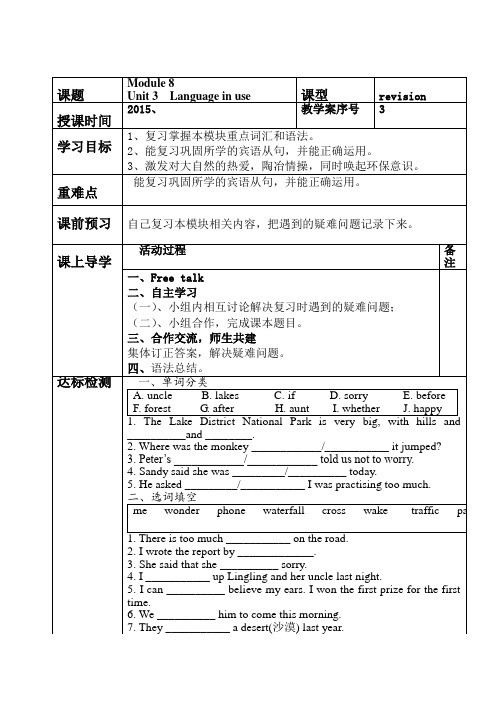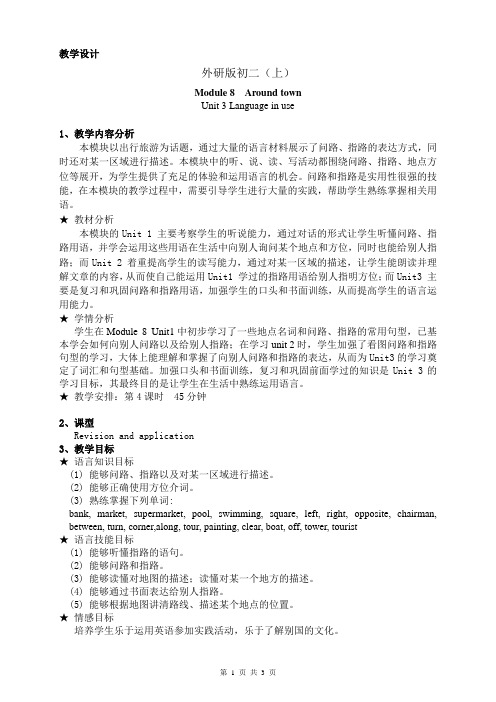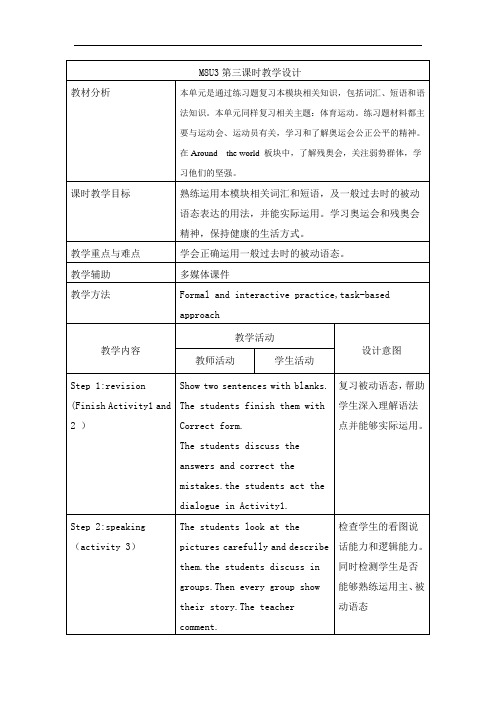M8U3公开课教案
- 格式:doc
- 大小:40.00 KB
- 文档页数:3

M8u3 Unusual pictures Period 1(教学设计)
I.课题:Module 8unit 3 Unusual pictures
教材:译林牛津版高中英语教材
II.教学背景分析
学习内容分析:
文本展示了不同寻常的画的制作过程:材料的准备、制作画作。
学生通过阅读文本会激发自己的创造力去创造自己的画作,甚至变废为宝。
文本逻辑结构清晰,语言平铺直述,只要理清材料和制作的步骤等要素,学生对文本的理解难度不大。
III.教学方法和手段
方法:启发、问答、讨论、合作、归纳汇报、评价
手段:黑板、PPT 、文本阅读、画作材料
IV.教学目标及重难点
教学目标:通过本节课的学习,学生能:
1.深度理解文本,掌握画作的制作步骤;
2.通过阅读、归纳、概括、迁移、分析、综合和评价提升学生各方面的能力;
3.合作制作和展示、评价小组画作。
重难点:
1.通过文本掌握画作如何制作;
2.通过合作制作本小组的画作;
3.展示、评价画作。
VI.教学设计特色说明
1.注重文本的阅读,目的在与让学生掌握文本结构;结合对文本的学习,小组合作
整合要点制作自己的画作;展示画作,形成自己的正确的评价;
2.学生结合学习和合作,分析、加工、整合、创造性的锻炼自己的逻辑思维和各种
能力。
感谢您的阅读,祝您生活愉快。


课题Module 8Unit 3 Language in use课型revision授课时间2015、教学案序号 3学习目标1、复习掌握本模块重点词汇和语法。
2、能复习巩固所学的宾语从句,并能正确运用。
3、激发对大自然的热爱,陶冶情操,同时唤起环保意识。
重难点能复习巩固所学的宾语从句,并能正确运用。
课前预习自己复习本模块相关内容,把遇到的疑难问题记录下来。
课上导学活动过程备注一、Free talk二、自主学习(一)、小组内相互讨论解决复习时遇到的疑难问题;(二)、小组合作,完成课本题目。
三、合作交流,师生共建集体订正答案,解决疑难问题。
四、语法总结。
达标检测一、单词分类A. uncleB. lakesC. ifD. sorryE. beforeF. forestG. afterH. auntI. whetherJ. happy1. The Lake District National Park is very big, with hills and__________and ________.2. Where was the monkey ____________/___________ it jumped?3. Peter’s ____________/____________ told us not to worry.4. Sandy said she was _________/__________ today.5. He asked _________/___________ I was practising too much.二、选词填空me wonder phone waterfall cross wake traffic path1. There is too much ___________ on the road.2. I wrote the report by _____________.3. She said that she __________ sorry.4. I ___________ up Lingling and her uncle last night.5. I can __________ believe my ears. I won the first prize for the firsttime.6. We __________ him to come this morning.7. They ___________ a desert(沙漠) last year.8. The river came pouring down in a ____________ off the hill.9. Keep to the ____________ or you may lose your way.10. –Did you have a ____________ time in Beijing last month? --Yes, we did.课后反思我的收获:我的不足:我的疑问:。

教学设计外研版初二(上)Module 8 Around townUnit 3 Language in use1、教学内容分析本模块以出行旅游为话题,通过大量的语言材料展示了问路、指路的表达方式,同时还对某一区域进行描述。
本模块中的听、说、读、写活动都围绕问路、指路、地点方位等展开,为学生提供了充足的体验和运用语言的机会。
问路和指路是实用性很强的技能,在本模块的教学过程中,需要引导学生进行大量的实践,帮助学生熟练掌握相关用语。
★教材分析本模块的Unit 1 主要考察学生的听说能力,通过对话的形式让学生听懂问路、指路用语,并学会运用这些用语在生活中向别人询问某个地点和方位,同时也能给别人指路;而Unit 2 着重提高学生的读写能力,通过对某一区域的描述,让学生能朗读并理解文章的内容,从而使自己能运用Unit1 学过的指路用语给别人指明方位;而Unit3 主要是复习和巩固问路和指路用语,加强学生的口头和书面训练,从而提高学生的语言运用能力。
★学情分析学生在Module 8 Unit1中初步学习了一些地点名词和问路、指路的常用句型,已基本学会如何向别人问路以及给别人指路;在学习unit 2时,学生加强了看图问路和指路句型的学习,大体上能理解和掌握了向别人问路和指路的表达,从而为Unit3的学习奠定了词汇和句型基础。
加强口头和书面训练,复习和巩固前面学过的知识是Unit 3的学习目标,其最终目的是让学生在生活中熟练运用语言。
★教学安排:第4课时 45分钟2、课型Revision and application3、教学目标★语言知识目标(1) 能够问路、指路以及对某一区域进行描述。
(2) 能够正确使用方位介词。
(3) 熟练掌握下列单词:bank, market, supermarket, pool, swimming, square, left, right, opposite, chairman, between, turn, corner,along, tour, painting, clear, boat, off, tower, tourist★语言技能目标(1) 能够听懂指路的语句。

Module 8Story time Unit 3 Language in usepart, hair, gold, forest, once, upon, once upon a1.Grasp the words and the expressions in this module2.Grasp the use of the past simple regular verbs1.Grasp the past simple regular verbs2.Be able to tell stories using the past simple regular verbsModule task Let students work in pairs. Look at the pictures and make e the words given.教师活动Module task 【参考答案】The father loved the little girl.The father and the little girl played games in the garden.The little girl fell off the boat and died in the sea.She changed into a bird called Jingwei.Her father watched the bird and was unhappy.The bird decided to fill up the sea with the stones.教师活动Write a story and then read your writing to your friends.本节课的教学活动设计,能够创设丰富的语境,设置循序渐进的学习任务,充分发挥学生的主体作用,引导学生合作学习、自主探究,重视“预习—展示—练习—反馈”的学习过程。

Module 4 Planes, ships and trainsUnit2 What is the best way to travel? 教学设计【目标确定的依据】1.相关课程标准陈述能够介绍自己或他人的旅行计划以及乘坐的交通工具。
2. 教材分析本节课的主要内容是总结与归纳本模块的语言知识以及形容词、副词最高级的用法,交通工具的描述。
3.学情分析通过前两节课的学习,学生对于形容词与副词的最高级有了一定的了解,本节课在此基础之上总结归纳形容词、副词最高级的用法,交通工具的描述。
【教学目标】1.归纳梳理Unit1与Unit2的基础知识,形成知识网络图,并学会在特定语境中灵活使用准确完成相似话题的题目。
2.合作探究掌握本模块的习惯用语、固定搭配和语言知识点并灵活运用。
3.通过纸笔测试提高学生的语言知识能力、信息组织和语言表达能力。
【教学重难点】重点:形容词、副词最高级的用法。
难点:谈论旅游计划。
【课时安排】1课时【评价任务】1.自主完成课本上的3、4、5、6、7学会在特定语境中灵活使用,听课本上的练习题7、8、提高学生对听力素材进行加工整合的能力。
2.小组合作掌握本模块的习惯用语、固定搭配和语言知识点并巩固记忆、灵活运用。
3. 设计根据句意及汉语提示完成单词,单项选择题两个题目检测学生的语言知识能力、信息组织和语言表达能力。
【教学活动设计】一、导入环节(一)导入新课,板书课题导入语:Good morning, class. Today, we are going to learn unit 3 of Module 4 Language in use. Let’s begin our class.(二)出示学习目标过渡语:Let’s read t he learning goals together.1.我能归纳梳理Unit1与Unit2的基础知识,形成知识网络图,并学会在特定语境中灵活使用准确完成相似话题的题目。
M8U3 The world of colors and lightThoughts on the design:本节课以看、说为主,通过Welcome to the unit部分所提供的5张图片,激活学生对绘画类别的了解,通过该部分相关问题的讨论,进一步激发学生的学习热情, 为本单元后面更深入的学习奠定基础。
Teaching aims:After learning this period,the students will be able to1。
understand and distinguish different types of paintings like “mural, still lifes, abstract art, nature painting and pictures of rich and famous people”;2. develop their interest in learning about art and painters.Teaching procedures:Step 1 lead—in1。
A video “Art Attack” appreciation (PPT4-5)After that,ask students questions like:1)Have you ever watched the program?What can you learn from it?2) What type of painting is it? Nature,abstract or still life painting?And why?2. Famous paintings appreciation (PPT6-8)Present some world famous paintings like “Mogao Caves wall paintings”, “Mona Lisa”,“The Last Supper",“Impression,sunrise”,“Sunflower” etc. and ask students what information they have got about these paintings and painters.Step 2 Brainstorming (PPT9)Ask students to work in groups and create a spider gram using the key word “painting”, encouraging them to find as many subcategories as possible that relate to painting。
Module 8 Around townUnit 3 language in useTeaching aims:1. To practice dialogues about directions.2. To understand some words and sentences.Teaching points:Key structures1. How do I get to the Forbidden City?2. Go straight ahead.3. Can you tell me the way to a park?4. Where can I do some shopping?5. It’s between the Great Hall of the People and the Museums.Teaching method:revision and practiceTeaching type:practice lessonTeaching aids:flashcards and tapeTeaching procedures:Step 1. RevisionReview and consolidate the vocabulary just learned in the first two units. Let students do Activity 1 and 2 and then check the answers.Step 2. PracticeLook at the map again. Match the questions with the answers. Ask and answer about your school.e.g. 1. Where is the library?2. How can I get to the science labs?3. Where can I use a computer?4. Where can I see the head teacher?5. Is there a playground?Step 3. Listening1. Ask students to read questions before listening. Listen twice and do Activity 5 and 6. Listen again and answer the questions. And then label the places. (bank bookshop bus stop flower store market post office restaurant supermarket)2. Listen again and answer the questions:(1) Why does the tourist want to go to the post office?(2) Why does he want a guidebook?(3) Where can he get a guidebook?(4) What is Marco’s?(5) How will they get to Marco’s?Step 4. Practice1. Look at your classroom and choose an object. Describe its position and other students guess what it is. Work in pairs. Drawn a small map of a place you know well, and say what you can do there. And do Activity 10 and 11, check their answers.2. Let the class read the information. Discuss with the students. Provide more information for the students.Step 5. Work in pairs1. Draw a small map of a place you know well. And then explain the map.2. Write down three other places you know, and say what you can do there.3. Match the two parts of the sentences.4. Fill in the blacks. Use the words and expressions in the box.Step 6. Around the world1. Ask the students to look at the picture and tell you what they can see.2. Read the passage and answer any questions the students have.Step 7. Main task1. Give directions around your town. Write a tour of your town. Say:(1) What are the most important places to see?(2) Where are they?(3) How can you get there?2. Write an email to a foreign friend and say how to get from the station or airport to your home.Step 8. Exercises句型转换。
公开课教案M8Unit 3 The world of colors and light
Teaching Design (Reading)
Teaching aims:
1.To read the student’s e-mail about visiting the master
2.To improve their reading ability about how to read a life story
3.To learn more about some masters and their masterpieces. Teaching important & difficult points:
1.How to help students to understand the text
2.Help students to improve their reading ability
3. Help students learn more about some masters and their masterpieces. Teaching Procedures:
Step 1:Lead-in
Watch the video and answer the questions. (The Davinci Code)
Do you know the name of the film?
Which famous artist and his masterpiece are mentioned in the film? Show some pictures.
Would you like to name any other artists?
Step 2: Fast reading.
Go through the passage as quickly as possible and try to find answers to the following questions.
1. How many masters has Li Ming visited on his trip?
2. Which countries has Li Ming visited on his trip?
Step 3: Listening
Step 4: Detailed reading
Read the e-mail carefully and answer the following questions.
1. What is Cubism?
2. Was Leonardo da Vinci just a famous painter?
3. Why did Claude Monet build a special garden at his home?
4. What’s the sad of V an Gogh’s life?
Step 5:Group work:
e your own words to introduce each artist mentioned in the passage
to other group members.
2.Suppose you have a chance to interview one of the artists, who would
you prefer to interview and what questions would you prepare?
Step 6: Discussion:
What have you learned from V an Gogh’s experiences?
Step 7: Homework
1.Go to the library to search more information about the famous painters and their woks.
2.Finish the following exercises.
1. Pablo Picasso developed different styles of painting in his life, and ________ is one of them.
A. cubism
B. impressionism
C. portrait
D. still life
2. Leonardo da Vinci wasn’t just a painter; he was also all of the following EXCEPT ________.
A. an architect
B. an engineer
C. a photographer
D. a sculptor
3. If you want to see the works of Glaude Monet, you should go to ________.
A. the Louvre Museum
B. the Musee d’Orsay
C. Amsterdam
D. the city of Malaga
4. ________ made van Gogh’s early paintings special, according to the passage.
A. The 800 oil paintings and 1,600 drawings
B. The style called impressionism
C. The 36 paintings towards the end of his life
D. His unsuccessful career while he was alive.
5. How many museums did Li Ming mention in the e-mail?
A. Two.
B. Three.
C. Four.
D. Five ACBBD。